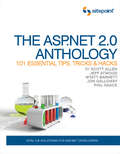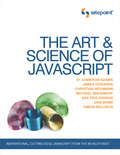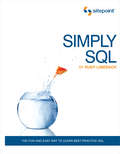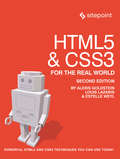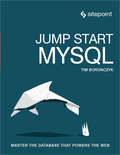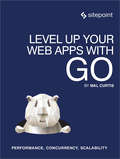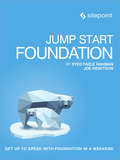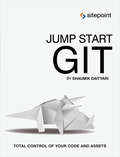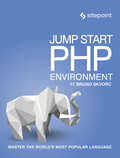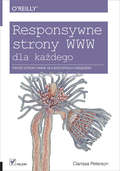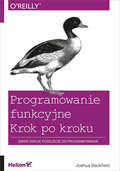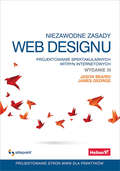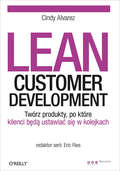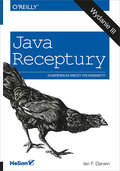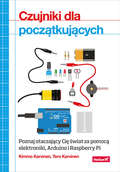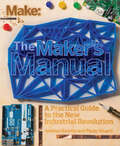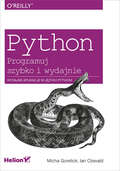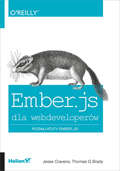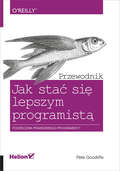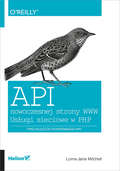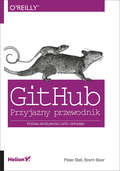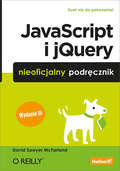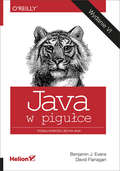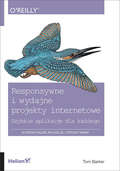- Table View
- List View
The ASP.NET 2.0 Anthology: 101 Essential Tips, Tricks & Hacks
by Jon Galloway Phil Haack Wyatt Barnett Scott Allen Jeff AtwoodAn ASP.NET 2.0 book that just helps you get things done!This book contains a collection of 101 best practice, object oriented solutions that you can easily adapt to your own projects.Coverage includes:Working with text, numbers, dates & timesAccessing data with ADO.NETForm validation under multiple sceneriosPage, Session and application state tipsAccess control in web applicationsProducing standards compliant outputEnhancing applications with AJAXWorking with EmailHandling errors and debuggingPerformance tips and pitfallsAnd much more!As a bonus, all book buyers get download access to the code archive which has all the examples in the book in both C# and VB.Back Cover"A comprehensive collection of ready-to-use ASP.NET solutions!"The ASP.NET 2.0 Anthology: 101 Essential Tips, Tricks & Hacks is a collection of solutions to the most common ASP.NET problems. Let five world-class ASP.NET professionals guide you through countless practical solutions using C# or VB.Learn to:Add interactivity with Ajax and JavaScript.Build a database access layer for improved portability.Sidestep the ASP.NET framework when required.Build data-driven applications quickly with SubSonic.Gracefull handle errors effectively.Work with email: send, parse, & manage attachments.Use component-based development for flexibility.Make your applications search engine friendly.Validate data input on forms.Create a user registration system.Use Master Pages to simplify development.Work with binary content.Improve the speed of your site, decrease bandwidth usage and speed up database queriesAnd lots more...
The Art & Science of JavaScript: Inspirational, Cutting-Edge JavaScript From the World's Best
by Michael Mahemoff Christian Heilmann James Edwards Cameron Adams Ara Pehlivanian Dan Webb Simon WillisonWe've assembled seven of the greatest minds in modern JavaScript to teach you the most inspirational techniques you'll ever use. From creating impressive mashups and stunning, dynamic graphics, to more subtle user-experience enhancements, you're about to be amazed by the true potential of this powerful language.With an all star line-up of authors including James Edwards, Michael Mahemoff, Ara Pehlivanian, Cameron Adams, Dan Webb, Christian Heilmann, and Simon Willison, this superb book will show you how to:Create a slick Google Maps and Flickr mashup.Build your own fully accessible 3D maze.Create stunning vector graphics using the canvas element.Have some fun with draggable and sortable table columns.Give your site some extra personality with client-side badges.Write better code faster using metaprogramming techniques.Become a debugging expert using pro-level Firebug tricks.Presented in full color, all of the books solutions are cross-browser and cross-platform compatible. Best of all, all the code used in the book is available for you to download and experiment with.Who Should Read This Book?This book is targeted at intermediate JavaScript developers who want to take their JavaScript skills to the next level without sacrificing web accessibility or best practice.If you have even a small amount of experience with JavaScript, and are comfortable enough programming in another language such as PHP or Java, you'll be just fine - we'll hold your hand along the way, and all of the code is available for you to download and experiment with on your own.
Simply SQL: The Fun and Easy Way to Learn Best-Practice SQL
by Rudy LimebackPacked with examples, Simply SQL is a step-by-step introduction to learning SQL. You'll discover how easy it is to use SQL to interact with best-practice, robust databases. Rather than bore you with theory, it focuses on the practical use of SQL with common databases and uses plenty of diagrams, easy-to-read text, and examples to help make learning SQL easy and fun. Step through the basic SQL syntax Learn how to use best practices in database design Master advanced syntax like inner joins, groups, and subqueries Understand the SQL datatypes And much more...
HTML5 & CSS3 For The Real World: Powerful HTML5 and CSS3 Techniques You Can Use Today!
by Estelle Weyl Louis Lazaris Alexis GoldsteinHTML5 and CSS3 for the Real World is your perfect introduction to the latest generation of web technologies. This easy-to-follow guide covers everything you need to know to get started today. You'll master the semantic markup available in HTML5, as well as how to use CSS3 to create amazing-looking websites without resorting to complex workarounds. You'll learn how to: Lose that pesky Flash habit by embracing native HTML5 videoSet type that truly supports your messageBuild intelligent web forms that users will love!Design modern web apps the shine on mobile devicesCreate dynamic, efficient graphics on the fly with SVG and canvasUse shiny new APIs to add geolocation and offline functionalityBuild your own full featured HTML5 website, the HTML5 Herald This easy-to-follow guide is illustrated with lots of examples, and leads readers through the process of creating great websites from start to finish using HTML5 and CSS3.
Jump Start MySQL: Master the Database That Powers the Web
by Timothy BoronczykGet a Jump Start on working with MySQL today! MySQL is an extremely popular open source relational database management system that that powers many of the applications on the Web. Discover why MySQL's speed, ease of use, and flexibility make it the database of choice for so many developers. In just one weekend with this hands-on tutorial, you'll learn how to: Get started with MySQLStore, modify, and retrieve dataWork with multiple tablesConnect to your database through codeProgram the databaseBack up your data
Level Up Your Web Apps With Go: Performance, Concurrency, Scalability
by Mal CurtisGo is an open-source language from Google that's a bit like C. Designed for programmer productivity, it's got a clean syntax, and emphasizes concurrency. This book gives you all you need to use Go in your web applications. You'll learn the basic concepts - language structures, the standard library, and Go tools - then tackle more advanced features like concurrency concepts, testing methodologies, and package structures. At each step, you'll get advice for better coding in Go. You'll see how to structure projects, how to use concurrency effectively, and best practices for testing - as well as many valuable hints and tips gleaned from real world experience of developing web applications with Go. You'll learn: Get to grips with Go language basics (types, the standard library, tools)Use Go with HTTPWork with imagesUnderstand concurrencyTest effectivelyMaster deploymentAnd much more ...
Jump Start Foundation: Get Up to Speed With Foundation in a Weekend
by Syed Fazle Rahman Joe HewitsonGet a Jump Start on building applications with Foundation today! Developed by Zurb, Foundation is a hugely popular CSS framework that's making the once-arduous process of crafting responsive web designs a breeze! Foundation was the first open-source front-end framework to be responsive, the first to be semantic, as well as the first to take a mobile-first approach. Read this book and discover why Foundation is fast becoming a favorite tool of top web designers. In just one weekend with this hands-on tutorial, you'll learn how to: Integrate Foundation into your projectsUnderstand the basic Foundation templateUtilize Foundation's impressive array of built-in componentsWork with Foundation's gridCustomize Foundation to work with any projectAnd much more!
Jump Start Git: Take Control of Your Code and Assets
by Shaumik DaityariGet a Jump Start on version control with Git today! Most engineers we meet prefer Git over other distributed version control systems. These systems let you store different versions of project files and directories, so you can roll back to an earlier one if something goes wrong. And since they're distributed, they smooth the path for dev team collaboration. But what is it about Git that makes it mission-critical on so many web projects? Spend just one weekend with this hands-on tutorial, and you'll know the answer. Understand Git's core philosophy.Get started with Git: install it, learn the basic commands, and set up your first project.Work with Git as part of a collaborative team.Use Git's debugging tools for maximum debug efficiency.Take control with Git's advanced features: reflog, rebase, stash, and more.Use Git with cloud-based Git repository host services like Github and Bitbucket.See how Git's used effectively on large open-source projects. Git was created by Linus Torvalds, who invented Linux, so it comes with the best credentials. What are you waiting for? Get a jump start on Git today.
Jump Start PHP Environment: Master the World's Most Popular Language
by Bruno SkvorcMany entry level PHP developers want a quick path to glory, a shortcut to "knowing PHP." Too many books and tutorials go straight into a pre-made, awful environment that just wants you to code, with no regard for security, version control, or other absolutely essential practices. This book is aimed at the absolute beginner who wants to start learning PHP, but aims to set you up with a thorough understanding of what makes for a good, modern, adaptable PHP environment before you start diving into PHP itself.This book will cover a the essential building blocks of a good PHP environment, including covering topics such as:The anatomy of a web requestThe importance of a good IDEUsing Composer for package managementVersion control with Git and GitHubDeployment and hosting optionsUsing virtual machinesBuild a sample app from scratch and deploy it -- the right wayAnd much more!
Responsywne strony WWW dla ka_dego
by Clarissa PetersonTwórz skalowalne strony WWW (RWD) dla wszystkich urz?dze?!Responsywne strony WWW umiej?tnie dostosowuj? si? do rozmiaru ka?dego ekranu, na jakim zechcesz je wy?wietli?. Ta ich w?a?ciwo?? pomaga równie? generowa? zyski! Po pierwsze, wystarczy utrzymywa? tylko jedn? wersj? responsywnej strony. Po drugie, Twoi potencjalni klienci i u?ytkownicy mog? zapozna? si? z Twoj? ofert? lub skorzysta? z niej praktycznie w dowolnym miejscu ?wiata. I to niezale?nie od tego, czy korzystaj? ze smartfona, z tabletu czy z komputera stacjonarnego!Je?eli chcesz nauczy? si? tworzy? takie strony, ta ksi??ka b?dzie dla Ciebie najlepszym ?ród?em! Ju? za chwil? dowiesz si?, w jaki sposób zbudowa? skalowalne strony WWW z wykorzystaniem najnowszych mo?liwo?ci kaskadowych arkuszy stylów CSS3 oraz j?zyka HTML5. Przekonasz si?, jak ?atwo mo?esz modyfikowa? style pod konkretne media oraz jak najlepiej zorganizowa? proces projektowania responsywnej strony WWW. Zaznajomisz si? te? z najlepszymi technikami poprawy wydajno?ci Twoich stron WWW. To jest obowi?zkowa lektura dla wszystkich programistów i projektantów stron WWW! Przygotuj strategi? tre?ci strony zanim zajmiesz si? jej wizualnym wygl?dem Dowiedz si?, dlaczego domy?lnym wzorcem powinna by? strona przystosowana do ma?ych ekranów Poznaj elementy j?zyka HTML i w?a?ciwo?ci stylów CSS niezb?dne do tworzenia skalowalnych stron Zastosuj zapytania o media, aby wy?wietla? ró?ne style CSS na ekranach ró?nej wielko?ci Modyfikuj obrazy, czcionki i sekcje nawigacji Stosuj techniki optymalizacyjne, aby tworzy? mniejsze i szybsze stronyOdkryj mo?liwo?ci responsywnych stron WWW!
Programowanie funkcyjne. Krok po kroku
by Joshua BackfieldZmie? swoje podej?cie do programowania!J?zyki funkcyjne zdobywaj? w?ród programistów coraz wi?ksz? popularno??. Jak bezbole?nie zmieni? sposób my?lenia na funkcyjny? U?atwi Ci to niniejsza ksi??ka, w ca?o?ci po?wi?cona temu podej?ciu do programowania.Poznaj podstawy teoretyczne programowania funkcyjnego, a nast?pnie zacznij zg??bia? tajniki typów funkcyjnych, rekurencji oraz zmiennych niepodlegaj?cych modyfikacji. Z kolejnych rozdzia?ów dowiedz si?, czym s? ewaluacja rygorystyczna i nierygorystyczna. Zobacz te?, jak wykona? dopasowanie do wzorca. Co jeszcze znajdziesz w tej ksi??ce? Wprowadzenie do j?zyka Scala, przedstawienie j?zyka Groovy oraz opis technik funkcyjnego programowania obiektowego to tylko niektóre z poruszanych w niej tematów. Je?eli chcesz zmieni? sposób programowania na funkcyjny, to doskona?a pozycja dla Ciebie!Dzi?ki tej ksi??ce: poznasz podstawy teoretyczne programowania funkcyjnego zaznajomisz si? z typami funkcyjnymi wykorzystasz funkcje anonimowe poznasz nowe wzorce projektowe zmienisz swoje podej?cie do programowaniaPrzekonaj si?, jak podej?cie funkcyjne mo?e u?atwi? Ci ?ycie!O autorzeJoshua F. Backfield jest starszym in?ynierem ds. rozwoju oprogramowania w firmie Dell SecureWorks, która jest wiod?cym w bran?y dostawc? zarz?dzalnych us?ug zabezpiecze? (ang. managed security service provider — MSSP). Jest odpowiedzialny za projektowanie i rozwój wielu wewn?trznych narz?dzi interfejsu u?ytkownika, a tak?e wielu procesów backendowych. Posiada tytu? licencjata technologii systemów elektronicznych z Southern Illinois University w Carbondale i tytu? magistra w dziedzinie informatyki z DePaul University. Pracowa? w wielu ró?nych j?zykach programowania, takich jak C, C++, Perl, Java, JavaScript oraz Scala, i wci?? uczy si? kolejnych. Przeniós? wiele natywnych aplikacji j?zyka C do j?zyka Scala. Wprowadzi? tak?e wielu swoich wspó?pracowników w tajniki j?zyka Scala i nauczy? ich jego podstawowych koncepcji programowania funkcyjnego.
Niezawodne zasady web designu. Projektowanie spektakularnych witryn internetowych. Wydanie III
by Jason Beaird James GeorgeNie musisz ucz?szcza? do akademii sztuk pi?knych, by tworzy? witryny marze?!Stworzenie doskona?ej strony WWW wymaga wspó?pracy grafika i programisty, który potrafi przeku? jego wizj? na j?zyk kodu. Czy jest mo?liwe po??czenie tych dwóch ról? Czy programista mo?e nauczy? si? tworzy? atrakcyjne, eleganckie i estetyczne strony WWW bez pomocy grafika? Dowiedz si?, jak to osi?gn?? i zoptymalizowa? swoj? prac?!Si?gnij po kolejne wydanie tej bogato ilustrowanej ksi??ki i poznaj najlepsze zasady projektowania stron internetowych. W kolejnych rozdzia?ach zdob?dziesz bezcenn? wiedz? na temat dobierania kolorów, tworzenia uk?adów stron oraz korzystania z tekstur. Ponadto poznasz szkielety Foundation i Bootstrap. Najnowsze wydanie tej cenionej ksi??ki k?adzie nacisk na tworzenie responsywnych stron, które prezentuj? si? dobrze zarówno na du?ych, jak i ma?ych ekranach. Ksi??ka ta jest doskona?? lektur? dla wszystkich pasjonatów tworzenia stron WWW!Dowiedz si?, jak: Dobiera? kolory, by komponowa? zabójcze schematy barw. Tworzy? elastyczne uk?ady stron, które wygl?da? b?d? rewelacyjnie na wszystkich urz?dzeniach. Wykorzystywa? tekstury, w tym pot?g? nawet najprostszych elementów takich, jak: punkt, linia, figura, g??bia czy dese?. Budowa? solidne uk?ady, efektywnie stosuj?c systemy siatek i bia?? przestrze?. Opanowa? sztuk? transformacji ... nudnych kompozycji w ol?niewaj?ce per?y przy pomocy samej typografii. Stosowa? frameworki w rodzaju Foundation i Bootstrap do tworzenia solidnie ustrukturyzowanych projektów. Wybiera?, modyfikowa? i pozycjonowa? grafiki na stronie.I wielu innych rzeczy...Przewodnik po projektowaniu stron dla programistów!
Lean Customer Development.
by Cindy AlvarezZnaj klienta swego Zweryfikuj swoj? hipotez?, rozmawiaj?c z w?a?ciwymi osobami. Krok po kroku naucz si? prowadzi? skuteczne wywiady Customer Development. Rozpoznawaj zachowania klientów, ich problemy i ograniczenia. Na podstawie pozyskanych w ten sposób informacji zbuduj minimalnie satysfakcjonuj?cy produkt, który pozwoli Ci potwierdzi?, co klienci s? sk?onni kupi? i czego b?d? u?ywa?. Dostosuj techniki sk?adaj?ce si? na model Customer Development do potrzeb du?ych organizacji, konserwatywnych bran? i istniej?cych ju? produktów.Jak tworzy? produkty, które ludzie b?d? chcieli kupowa?? Bez wzgl?du na to, czy jeste? w?a?cicielem niewielkiej firmy czy pracownikiem wielkiego koncernu, zadajesz sobie to samo pytanie. Je?li szukasz niezawodnej metody badania potrzeb i preferencji klientów, dzi?ki której zaoszcz?dzisz wiele miesi?cy pracy oraz mnóstwo pieni?dzy, zapraszamy do ?wiata Lean Customer Development.To metoda id?ca o krok dalej ni? tradycyjne techniki marketingowe. Nie tylko pomo?e Ci pozna? potrzeby i preferencje klientów oraz zg??bi? user experience, ale zweryfikuje t? wiedz? na drodze eksperymentów naukowych. Dzi?ki odpowiedniemu po??czeniu otwartych wywiadów oraz szybkich i elastycznych technik badawczych dowiesz si?, jak zachowuj? si? Twoi potencjalni klienci, jakie problemy usi?uj? rozwi?za?, a tak?e co ich frustruje, a co jest przedmiotem ich zachwytów. Dowiedz si?, jak zmienia? zachowania konsumentów, tworzy? wielkie produkty i budowa? trwa?? firm?.Ksi??ki z serii Lean, serii, której redaktorem jest http://helion.pl/autorzy/eric-ries,eriris.htm">Eric Ries, za?o?yciel ruchu Lean Startup. Niniejsza ksi??ka k?adzie nacisk na podstawowe aspekty metodologiczne i zawiera praktyczne przyk?ady, opracowane z my?l? o deweloperach, mened?erach i innych cz?onkach zespo?u Twojego startupu. Dzi?ki niej poznasz skuteczne narz?dzia i przyjmiesz sposób my?lenia sprzyjaj?cy podejmowaniu szybkich i m?drych decyzji.
Java. Receptury. Wydanie III
by Ian F. DarwinRozwi?zania i przyk?ady dla programistów u?ywaj?cych j?zyka JavaJava to jeden z j?zyków programowania najch?tniej wybieranych do tworzenia zaawansowanych systemów informatycznych. Systemy bankowe, aukcyjne oraz inne zaawansowane programy wspomagaj?ce codzienn? prac? tysi?cy ludzi opieraj? si? na Javie i narz?dziach z ni? zwi?zanych. Je?eli chcesz ?mia?o wkroczy? w ?wiat tego j?zyka, musisz mie? t? ksi??k?!Ksi??ka nale?y do cenionej serii „Receptury”, która przedstawia ró?ne zagadnienia w postaci krótkich przepisów. Nie inaczej jest w tym przypadku. Si?gnij po ni? i zobacz, jak kompilowa?, uruchamia? i testowa? tworzony kod. W kolejnych rozdzia?ach zaznajomisz si? z najlepszymi metodami przetwarzania ci?gów znaków oraz nauczysz si? korzysta? z wyra?e? regularnych i wykonywa? operacje na liczbach. Ponadto zdob?dziesz dog??bn? wiedz? na temat systemu wej?cia-wyj?cia, u?ywania systemu plików, sieci oraz drukarek. Ksi??ka ta jest obowi?zkow? pozycj? na pó?ce ka?dego programisty Javy!Przedstawione receptury obejmuj?: Sposoby kompilacji, uruchamiania i testowania aplikacji. Manipulacj?, porównywanie i zmian? organizacji tekstów. U?ycie wyra?e? regularnych do dopasowywania tekstów i wzorców. Obs?ug? liczt, dat i czasu. Okre?lanie struktury danych przy u?yciu kolekcji, tablicy i innych typów. Techniki programowania obiektowego i funkcyjnego. Operacje na katalogach i systemie plików. Obs?ug? grafiki, d?wi?ku i wideo. Tworzenia aplikacji o graficznym interfejsie u?ytkownika, w tym Java FX i obs?ug? zdarze?. Programowanie sieciowe, zarówno klientów jak i serwerów. Dost?p do baz danych przy u?yciu JPA, Hibernate oraz JDBC. Przetwarzenie danych w formatach JSON oraz XML. Wielow?tkowo?? i wspó?bie?no??.Najlepsze przepisy dla programistów Javy! Ian F. Darwin - swoj? przygod? w binarnym ?wiecie rozpocz?? w 1980 roku od pracy z systemem operacyjnym UNIX. Autor narz?dzia file znanego z systemów Linux oraz BSD. Programista Javy od 1995 roku. Autor darmowych narz?dzi: PassMaker, JpsTrack. Pracownik Learning Tree International — ?wiatowego lidera w zakresie organizacji kursów technicznych.
Czujniki dla pocz?tkuj?cych. Poznaj otaczaj?cy Ci? ?wiat za pomoc? elektroniki, Arduino i Raspberry Pi
by Tero Karvinen Kimmo KarvinenZdob?d? informacje na temat ?wiata zewn?trznego!Arduino oraz Raspberry Pi to p?ytki, które sprawi?y, ?e ?wiat elektroniki sta? si? dost?pny dla wszystkich. Z ich pomoc? ka?dy amator mo?e sprawnie zrealizowa? projekt, o którym marzy? od zawsze. Fantastyczne mo?liwo?ci oraz ?atwo??, z jak? mo?na je wykorzysta?, przyczyni?y si? do ich ogromnej popularno?ci. Je?eli jednak chcesz zbudowa? bardziej wyrafinowany uk?ad, b?dziesz potrzebowa? informacji o ?wiecie zewn?trznym. Dostarcz? Ci ich czujniki!Je?eli chcesz zorientowa? si?, jak szeroki wachlarz czujników dost?pny jest dla Raspberry Pi oraz Arduino, trafi?e? na doskona?? ksi??k?. Znajdziesz w niej bogato ilustrowane opisy zastosowania przeró?nych sensorów. Pomiar obrotu, jasno?ci ?wiat?a, temperatury oraz odleg?o?ci to tylko niektóre z opcji. Z kolejnych rozdzia?ów dowiesz si?, jak wykorzysta? przycisk monostabilny oraz zbudowa? urz?dzenie regulowane czujnikiem podczerwieni. Ksi??ka ta jest znakomitym ?ród?em informacji dla pasjonatów chc?cych tworzy? zaawansowane projekty z u?yciem dost?pnych na rynku czujników.Dzi?ki tej ksi??ce: wykorzystasz czujnik temperatury zareagujesz na zmiany w o?wietleniu zastosujesz czujnik FlexiForce stworzysz jeszcze bardziej zaawansowany uk?ad elektronicznyZbuduj wymarzony uk?ad, reaguj?cy na dane ze ?rodowiska zewn?trznego!
The Maker's Manual: A Practical Guide to the New Industrial Revolution
by Patrick Di Justo Paolo Aliverti Andrea MaiettaThe Maker's Manual is a practical and comprehensive guide to becoming a hero of the new industrial revolution. It features dozens of color images, techniques to transform your ideas into physical projects, and must-have skills like electronics prototyping, 3d printing, and programming. This book's clear, precise explanations will help you unleash your creativity, make successful projects, and work toward a sustainable maker business. Written by the founders of Frankenstein Garage, which has organized courses since 2011 to help makers to realize their creations, The Maker's Manual answers your questions about the Maker Movement that is revolutionizing the way we design and produce things.
Python. Programuj szybko i wydajnie
by Ian Ozsvald Micha GorelickWydajne aplikacje w j?zyku Python!Python to skryptowy j?zyk programowania istniej?cy na rynku od wielu lat — jego pierwsza wersja pojawi?a si? w 1991 roku. Przejrzysto?? kodu ?ród?owego by?a jednym z g?ównych celów Guida van Rossuma, twórcy tego j?zyka. Dzi? Python cieszy si? du?? popularno?ci?, co z jednej strony ?wiadczy o jego przydatno?ci, a z drugiej gwarantuje u?ytkownikom szerokie wsparcie spo?eczno?ci programistów j?zyka. Python jest elastyczny, dopuszcza ró?ne style programowania, a dzi?ki temu znajduje zastosowanie w wielu miejscach ?wiata IT.Je?eli chcesz w pe?ni wykorzysta? mo?liwo?ci Pythona i tworzy? wydajne rozwi?zania, to koniecznie zaopatrz si? w t? ksi??k?! Dzi?ki niej dowiesz si?, jak wykorzysta? profilowanie do lokalizowania „w?skich garde?”, oraz poznasz efektywne techniki wyszukiwania danych na listach, w s?ownikach i zbiorach. Ponadto zdob?dziesz wiedz? na temat oblicze? macierzowych i wektorowych oraz zobaczysz, jak kompilacja do postaci kodu C wp?ywa na wydajno?? Twojego rozwi?zania. Osobne rozdzia?y zosta?y po?wi?cone wspó?bie?no?ci oraz modu?owi multiprocessing. Opanowanie tych zagadnie? pozwoli Ci ogromnie przyspieszy? dzia?anie Twojej aplikacji. Na sam koniec nauczysz si? tworzy? klastry i kolejki zada? oraz optymalizowa? zu?ycie pami?ci RAM. Rozdzia? dwunasty to gratka dla wszystkich — zawiera najlepsze porady specjalistów z bran?y! Ksi??ka ta jest obowi?zkow? lektur? dla wszystkich programistów chc?cych tworzy? wydajne rozwi?zania w j?zyku Python.Poznaj lepiej narz?dzia numpy i Cython, a tak?e narz?dzia profiluj?ceDowiedz si?, jak w j?zyku Python dokonywana jest abstrakcja bazowej architektury komputera.U?yj profilowania do znajdowania „w?skich garde?” zwi?zanych z wykorzystaniem czasu procesora i pami?ci.Utwórz wydajne programy, wybieraj?c odpowiednie struktury danych.Przyspiesz obliczenia oparte na macierzach i wektorach.Zastosuj narz?dzia do kompilacji kodu Python do postaci kodu maszynowego.Zarz?dzaj jednocze?nie wieloma operacjami obliczeniowymi i operacjami wej?cia-wyj?cia.Przekszta?? kod przetwarzania wspó?bie?nego w celu uruchomienia go w klastrze lokalnym lub zdalnym.Rozwi?? du?e problemy, u?ywaj?c mniej pami?ci RAM.Wyci?nij z Pythona siódme poty!
Ember.js dla webdeveloperów
by Jesse Cravens Thomas Q BradyPoznaj atuty Ember.js!Ember.js to biblioteka j?zyka JavaScript, dzi?ki której mo?esz sprawnie budowa? aplikacje na podstawie wzorca MVC (ang. Model View Controller). Ember.js znakomicie sprawdza si? przy tworzeniu jednostronicowych aplikacji internetowych (ang. Single Page Applications), a ponadto usprawnia automatyczne aktualizowanie szablonów czy dwustronne wi?zanie danych. Je?eli chcesz zg??bi? tajniki tej biblioteki, ta ksi??ka jest dla Ciebie.Dzi?ki niej poznasz potencja? Ember.js, jej atuty oraz techniki pracy. Lektura kolejnych rozdzia?ów pozwoli Ci pozna? zasady dzia?ania generatora aplikacji Ember i szablonów, a tak?e proces budowy modelu danych i kontrolerów. Na sam koniec dowiesz si?, jak zapisywa? dane po stronie klienta. Po zg??bieniu mo?liwo?ci Ember.js nauczysz si? przygotowywa? serwer, który b?dzie przetwarza? ??dania wysy?ane z Twojej aplikacji. W tym celu wykorzystasz Rails MVC. W trakcie lektury zbudujesz w?asn? aplikacj? o nazwie Rock’n’roll. Jeste? ciekaw, co potrafi? Si?gnij po t? ksi??k? i przekonaj si? sam! Przygotuj ?rodowisko pracy oraz wygeneruj podstawowy kod. Sprawd?, w jaki sposób „ergonomia” zapewniana przez Ember pozwala minimalizowa? ilo?? kodu. Przygotuj szablony dla prototypu ksi??ki dzi?ki Handlebars.js. Wykorzystaj rutery do zarz?dzania stanem aplikacji bez prze?adowywania zawarto?ci strony. Po??cz kontrolery i widoki ze zdarzeniami oraz synchronizuj dane dzi?ki powi?zaniom. Przygotuj infrastruktur? wspieraj?c? Ember za pomoc? REST-owego API lub Ruby on Rails. Wykorzystaj bibliotek? Data do zapisywania danych i komunikacji z infrastruktur? wspieraj?c?. Twórz uniwersalne modularne wid?ety rozszerzaj?ce mo?liwo?ci Twoich aplikacji.Pisz ambitne programy w JavaScript. Z Ember.js zaawansowane aplikacje internetowe s? w Twoim zasi?gu!
Jak sta? si? lepszym programist?. Przewodnik
by Pete GoodliffePodr?cznik prawdziwego programisty!Zawód programisty jak ?aden inny wymaga ci?g?ego rozwoju, nauki i doskonalenia. Ka?dy dzie? to nowe wyzwania, techniki programistyczne oraz kolejne linie wysokiej jako?ci kodu. Zastanawiasz si?, co jeszcze mo?esz zrobi?, aby sta? si? lepszym programist?? Chcesz zaimponowa? ciekawymi koncepcjami oraz wprowadzi? znacz?ce ulepszenia w codziennej pracy? Trafi?e? na ksi??k?, która sprawi, ?e Twój kod nabierze nowego blasku!Na kolejnych stronach tej ksi??ki przeczytasz o tym, jak powinien by? sformatowany kod ?ród?owy, jakie stosowa? nazewnictwo oraz jak usuwanie zb?dnego kodu wp?ywa na jego jako??. Nauczysz si? odnajdywa? b??dy w kodzie i pisa? dobre testy. Dowiesz si? tak?e, jak w pe?ni korzysta? z mo?liwo?ci systemu kontroli wersji. Ksi??ka ta jest obowi?zkow? lektur? dla ka?dego programisty ceni?cego sobie ci?g?y rozwój, d??enie do doskona?o?ci oraz tworzenie ?wietnego kodu! Techniki z poziomu kodu, dotycz?ce pisania wierszy kodu, testów, debugowania i radzenia sobie ze z?o?ono?ci?. Praktyki, podej?cia i postawy: zachowaj prostot?, wspó?pracuj z innymi, wykorzystuj gotowe rozwi?zania i twórz elastyczny kod. Strategie skutecznego uczenia si?, etycznego post?powania, szukania wyzwa? i unikania stagnacji. Praktyczne metody ko?czenia zada?: u?ywanie w?a?ciwych narz?dzi, ustalanie, jak ma wygl?da? gotowe rozwi?zanie, i szukanie pomocy ze strony wspó?pracowników. Nawyki dobrej wspó?pracy z innymi i traktowania programowania jak zaj?cia spo?ecznego.Obowi?zkowa lektura ka?dego programisty!
API nowoczesnej strony WWW. Us?ugi sieciowe w PHP
by Lorna Jane MitchellTwój klucz do doskona?ego API!Za sukcesem i si?? najpopularniejszych serwisów w sieci cz?sto stoi decyzja o szerokim udost?pnieniu API (ang. Application Programming Interface). Dzi?ki temu programi?ci z ca?ego ?wiata mog? tworzy? rozwi?zania oparte na istniej?cych us?ugach, integrowa? ró?ne systemy oraz tworzy? rozszerzenia. Si?gnij po t? ksi??k?, naucz si? korzysta? z udost?pnionego API i zbuduj w?asne.Poznaj tajniki budowania przyjaznego interfejsu API. Ta ksi??ka pomo?e Ci zorientowa? si?, jak dzia?a protokó? HTTP, jakie metody udost?pnia oraz jakie informacje mo?esz znale?? w nag?ówkach. Po opanowaniu podstaw przejdziesz do najpopularniejszych formatów wymiany informacji pomi?dzy systemami — JSON oraz XML. Zaznajomisz si? te? z us?ugami SOAP, RPC i REST. Na sam koniec dowiesz si?, jak projektowa? niezawodne us?ugi oraz obs?ugiwa? b??dy. Je?eli chcesz, ?eby Twoje API zainteresowa?o innych programistów, musisz zadba? o jego dobr? dokumentacj?. Zdob?d? niezb?dn? wiedz? o PHP! Poznasz protokó? HTTP, czasowniki cyklu ??da? i odpowiedzi oraz nag?ówki i ciasteczka. Dowiesz si?, kiedy lepiej jest u?y? formatu JSON, a kiedy XML. Nauczysz si? tworzy? us?ugi typu RPC, SOAP i RESTful. Poznasz wiele narz?dzi i technik diagnozowania us?ug sieciowych HTTP. Nauczysz si? wybiera? najlepszy rodzaj us?ugi dla swoich aplikacji i dowiesz si?, jak tworzy? niezawodne us?ugi sieciowe. Nauczysz si? dokumentowa? swoje interfejsy API — oraz projektowa? w nich mechanizmy obs?ugi b??dów.Zbuduj API zgodne z oczekiwaniami innych programistów!
Interfejs API. Strategia programisty
by Dan Woods Daniel Jacobson Greg BrailPoznaj potencja? interfejsów API!Internet to gigantyczna sie? urz?dze? po??czonych ze sob?. Jego potencja? wykorzystuj? wszyscy i ka?dy jest ?wiadom tego, ?e pojedyncze urz?dzenie bez po??czenia z sieci? nic nie znaczy. Podobnie jest z systemami informatycznymi. Mo?liwo?? integracji z sieci?, tworzenia rozszerze? oraz wymiany danych pomaga twórcom aplikacji rozwin?? skrzyd?a i odnie?? sukces na szerok? skal?. Zastanawiasz si?, jak otworzy? Twój system na ?wiat? Interfejs API to jedyna droga!Si?gnij po t? ksi??k? i przekonaj si?, jak przygotowa? wygodny interfejs API, z którego programi?ci b?d? korzystali z przyjemno?ci?. Na kolejnych stronach znajdziesz kluczowe zasady projektowania interfejsów API, sposoby zabezpieczania API oraz zarz?dzania u?ytkownikami. Ponadto dowiesz si?, jak zarz?dza? ruchem sieciowym, obs?ugiwa? interfejs API oraz mierzy? sukces Twojego API. Na sam koniec zobaczysz, jak zaanga?owa? projektantów w proces adaptacji. Ta ksi??ka jest doskona?ym ?ród?em informacji dla wszystkich osób chc?cych zrozumie?, czym s? interfejsy API, jak wykorzysta? drzemi?cy w nich potencja? oraz jak unikn?? typowych zagro?e? i problemów. Twoja lektura obowi?zkowa! Dowiedz si? o rozwoju interfejsów API, a tak?e dlaczego Twoja firma mo?e ich wymaga?. Zaznajom si? z rolami w?a?cicieli zasobów, dostawców i projektantów w ?a?cuchu warto?ci interfejsu API. Opracuj strategie zwi?zane z projektowaniem, implementowaniem i wprowadzeniem produktu na rynek. Opracuj efektywny proces na potrzeby zarz?dzaniami zabezpieczeniami i u?ytkownikami. Rozwi?? problemy natury prawnej, takie jak zarz?dzanie prawami i warunki u?ytkowania. Zarz?dzaj ruchem sieciowym i komfortem pracy u?ytkowników za pomoc? pewnego modelu operacyjnego. Okre?l metryki wymagane do ustalenia skali powodzenia interfejsu API.Wszystko, co powiniene? wiedzie? o interfejsach API!
GitHub. Przyjazny przewodnik: Przyjazny Przewodnik
by Peter Bell Brent BeerPoznaj mo?liwo?ci Gita i GitHuba!Git zrewolucjonizowa? ?wiat systemów kontroli wersji. Koncepcja rozproszonego systemu podbi?a serca programistów i ustanowi?a trendy na kolejna lata. Co powsta?o z po??czenia Gita i serwisu udost?pniaj?cego miejsce oraz narz?dzia dla programistów korzystaj?cych z Gita? To GitHub — najpopularniejsze miejsce w sieci, w którym znajdziesz tysi?ce projektów. GitHub wytycza dzi? ?cie?ki dla platform u?atwiaj?cych prac? z rozproszonymi systemami kontroli wersji.Ta ksi??ka zosta?a w ca?o?ci po?wi?cona w?a?nie GitHubowi. Si?gnij po ni? i przekonaj si?, jakie us?ugi oferuje ten serwis oraz jak wykorzysta? jego potencja? w Twoim projekcie. W trakcie lektury dowiesz si?, jak przegl?da? udost?pniony kod, wspó?pracowa? przy projektach oraz dostarcza? poprawki. Ponadto nauczysz si? zarz?dza? zg?oszonymi przez u?ytkowników problemami w Twoim kodzie oraz opanujesz najlepsze praktyki konfigurowania Twojego repozytorium. Na sam koniec poznasz narz?dzia przeznaczone dla systemów MacOS i Windows, a s?u??ce do wspó?pracy z serwisem GitHub. Ksi??ka ta jest obowi?zkow? lektur? dla wszystkich czytelników chc?cych w pe?ni wykorzysta? potencja? drzemi?cy w tym serwisie. Dowiedz si? jak i dlaczego ludzie u?ywaj? GitHuba do wspó?pracy. Przegl?daj bie??cy stan projektu — najnowsze zmiany, prace do wykonania i histori? poprawek. Twórz i edytuj pliki w GitHubie bez znajomo?ci systemu Git. Sugeruj zmiany w projektach, w których nie masz uprawnie? do bezpo?redniego wprowadzania poprawek. U?ywaj narz?dzi do obs?ugi problemów i zg?osze?, twórz ga??zie w celu definiowania nowych funkcji i wspólnej pracy nad zmianami. Twórz nowe repozytoria GitHuba, z uwzgl?dnieniem praw dost?pu do swojego projektuZaawansowany system kontroli wersji dla ka?dego!
JavaScript i jQuery. Nieoficjalny podr?cznik. Wydanie III
by David Sawyer McFarlandDuet nie do pokonania!JavaScript to j?zyk, którego pocz?tki si?gaj? lat dziewi??dziesi?tych XX wieku. Po pocz?tkowych problemach, gdy by? masowo blokowany przez u?ytkowników, obecnie prze?ywa swój najlepszy okres. Trudno wyobrazi? sobie bez niego nowoczesn? aplikacj? internetow?. Niew?tpliwie du?y wp?yw na wzrost popularno?ci JavaScriptu mia?a biblioteka jQuery, która usprawni?a korzystanie z tego j?zyka.Ta ksi??ka to wyj?tkowy podr?cznik prezentuj?cy mo?liwo?ci niesamowitego duetu JavaScript – jQuery. Si?gnij po ni?, a zagwarantujesz sobie godziny pasjonuj?cej lektury i odkrywania sk?adni j?zyka, typowych konstrukcji oraz najlepszych technik tworzenia programów. Ponadto dowiesz si?, jak sprawnie manipulowa? obiektami w drzewie DOM, reagowa? na zdarzenia oraz wymienia? informacje z serwerem za pomoc? ??da? AJAX. Na sam koniec zdob?dziesz bezcenn? wiedz? na temat diagnozowania problemów ze skryptami, korzystania z dokumentacji jQuery oraz przechowywania danych w magazynie lokalnym u?ytkownika. Ksi??ka ta jest obowi?zkow? lektur? dla ka?dego webdevelopera!Spraw, by Twoje strony ?y?y. Korzystaj z jQuery, ?eby tworzy? interaktywne elementy reaguj?ce na poczynania u?ytkowników. Poznaj jQuery UI. Rozbuduj tworzone interfejsy u?ytkownika stosuj?c grupy kart, okna dialogowe, wid?ety do wyboru daty i tak dalej. Wy?wietlaj ?adne i u?yteczne formularze. Pobieraj informacje od u?ytkowników, pomagaj klientom w zakupach i zapewniaj cz?onkom spo?eczno?ci mo?liwo?? dzielenia si? przemy?leniami. Wyjd? poza ramy przegl?darki korzystaj?c z technologii Ajax. Komunikuj si? z serwerem WWW, by aktualizowa? strony bez ich od?wie?ania. Zastosuj swoje nowe umiej?tno?ci w praktyce. Krok po kroku twórz nowe aplikacje, korzystaj?c przy tym z jQuery i wid?etów jQuery UI. Poznawaj zaawansowane zagadnienia. Korzystaj z narz?dzia ThemeRoller by dostosowywa? wygl?d wid?etów; unikaj popularnych b??dów, które programi?ci cz?sto pope?niaj?.Wykorzystaj w pe?ni mo?liwo?ci wspó?czesnych przegl?darek internetowych!David Sawyer McFarland – od ponad 20 lat zajmuje si? tworzeniem stron WWW i zarz?dzaniem tymi stronami. Jest prezesem firmy Sawyer McFarland Media. Wcze?niej pracowa? jako webmaster na Uniwersytecie Stanu Kalifornia oraz w Berkeley Multimedia Research Center. Jest autorem ksi??ek po?wi?conych Adobe Dreamweaverowi oraz CSS.
Java w pigu?ce. Wydanie VI
by David Flanagan Benjamin J EvansPoznaj nowo?ci j?zyka Java!Java to j?zyk programowania wybierany wsz?dzie tam, gdzie s? wymagane najwy?sze bezpiecze?stwo i wydajno??. Znajduje zastosowanie przy tworzeniu systemów bankowych oraz zaawansowanych aplikacji do zarz?dzania przedsi?biorstwami. S? to obszary, w których pomy?ki bywaj? niezwykle drogie. Ale to nie jedyne zastosowania Javy! Ten j?zyk sprawdza si? równie? wtedy, gdy trzeba szybko stworzy? aplikacj? internetow? (niezale?nie od jej wielko?ci) albo narz?dzia ró?nego przeznaczenia. Java przyda si? wsz?dzie!W ostatnim czasie na rynku pojawi?y si? dwie kolejne wersje tego j?zyka, oznaczone numerami 7 i 8. Zawieraj? one wiele nowo?ci i ulepsze?, dzi?ki którym ?ycie programisty staje si? prostsze, a tworzone oprogramowanie — lepsze. Najnowsze wydanie tej cenionej ksi??ki zosta?o uzupe?nione o informacje na temat tych w?a?nie wersji. Dzi?ki niej b?yskawicznie poznasz i wykorzystasz nowe techniki w codziennej pracy. Si?gnij po ten podr?cznik i poznaj najlepsze techniki programowania wspó?bie?nego, zasady podej?cia obiektowego oraz mo?liwo?ci asynchronicznego wykonywania operacji wej?cia-wyj?cia. Ta ksi??ka jest obowi?zkow? lektur? dla wszystkich programistów j?zyka Java! Poznasz szczegó?owo j?zyk programowania Java i dowiesz si?, jakie zmiany wprowadzono w Javie 8. Nauczysz si? programowania obiektowego przy u?yciu podstawowej sk?adni Javy. Poznasz typy ogólne, wyliczenia, adnotacje i wyra?enia lambda. Nauczysz si? podstawowych technik projektowania obiektowego. Poznasz techniki wspó?bie?no?ci i ich ?cis?y zwi?zek z modelem pami?ci. Nauczysz si? u?ywa? kolekcji Javy i pos?ugiwa? si? typowymi formatami danych. Szczegó?owo zbadasz najnowsze interfejsy API wej?cia i wyj?cia Javy, w??cznie z kana?ami asynchronicznymi. Dowiesz si?, jak wykonywa? kod JavaScript w maszynie wirtualnej Javy za pomoc? Nashorna. Poznasz narz?dzia programistyczne dost?pne w pakiecie OpenJDK.Poznaj najskrytsze tajemnice j?zyka Java!
Responsywne i wydajne projekty internetowe. Szybkie aplikacje dla ka?dego
by Tom BarkerSuperwydajne aplikacje i strony WWW!1024×768, 800×600 — czy te liczby co? Ci mówi?? To najpopularniejsze rozdzielczo?ci ekranu, które obowi?zywa?y w czasach przed mobiln? rewolucj?. Obecnie u?ytkownicy korzystaj? z przeró?nych ekranów, wy?wietlaj?cych obrazy w wielu innych rozdzielczo?ciach. Jak sobie z tym poradzi?? Jak tworzy? strony WWW, które b?d? dzia?a? poprawnie na ka?dym dost?pnym urz?dzeniu? Jak rozwi?za? problemy z wydajno?ci?? Na te i dziesi?tki innych pyta? odpowiada ta niezwyk?a ksi??ka.Si?gnij po ni? i zapoznaj si? z najnowszymi trendami w tworzeniu responsywnych i wydajnych stron WWW oraz aplikacji internetowych. W trakcie lektury zdob?dziesz bezcenn? wiedz? na temat mierzenia wydajno?ci aplikacji oraz czynników, które maj? na ni? wp?yw. Kolejne rozdzia?y dostarcz? Ci wyczerpuj?cych informacji dotycz?cych ciekawych rozwi?za? problemu wydajno?ci po stronie klienta oraz serwera, a ponadto zaprezentuj? techniki ci?g?ego testowania wydajno?ci. Przekonaj si?, jak istotne jest zapewnianie obrazów dopasowanych do urz?dzenia oraz stosowanie pami?ci podr?cznej. Poznaj dost?pne responsywne szkielety oraz ich ocen? wed?ug osobistych kryteriów autora. Jest to doskona?a lektura dla wszystkich osób pod??aj?cych za trendami w tworzeniu stron WWW i aplikacji internetowych. Uzyskaj podstawowe informacj? dotycz?ce wydajno?ci stron i narz?dzi do jej mierzenia. Pisz funkcjonalno?ci przy wykorzystaniu NodeJS, które zaserwuj? zasoby przystosowane do urz?dzenia klienta. Poznaj rozwi?zania dzia?aj?ce po stronie klienta, takie jak leniwe ?adowanie ca?ych sekcji strony — w??cznie z obrazami, stylami i zawarto?ci?. Sprawdzaj zgodno?? z umow? SLA poprzez automatyczne testy napisane w PhantomJS. Przeanalizuj kilka responsywnych frameworków, oraz autorski framework Toma Barkera dzia?aj?cy po stronie serwera.Poznaj sposoby tworzenia wydajnych i responsywnych aplikacji internetowych!Tom Barker — jest zwi?zany z wytwarzaniem oprogramowania od lat 90. XX wieku. Aktualnie pe?ni funkcj? dyrektora ds. wytwarzania oprogramowania w firmie Comcast. Interesuje si? analiz? danych i ich wizualizacj?. Szczególn? uwag? przyk?ada do tworzenia kodu wysokiej jako?ci.
